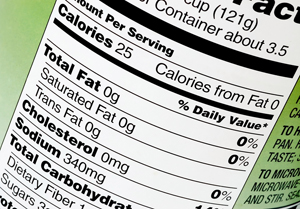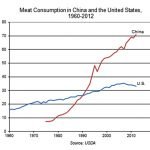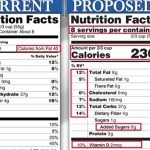Time and time again government health regulations have been on the wrong side of dietary issues. Some of this is simply the result of lobbyists and campaign contributions shaping those regulations to maximize industry profits over consumer health–as with Monsanto, DuPont and Koch Industries guiding public policy on GMO labeling. Other times, it’s fueled by the desire to advance political careers by creating a boogieman to publically attack in the name of protecting the public–as the NY Attorney General is doing with supplements. But oftentimes, government regulation is spawned by astounding, willful ignorance. Make no mistake, Senator James Inhofe was speaking for more than just himself when, explaining his position on Climate Change, he said, “I’m not a scientist.” Unfortunately, although Inhofe may not be a scientist, he does happen to be Chair of the Environment and Public Works Committee. You would hope that a Senator in charge of the Environment would want to at least become conversant in the science surrounding those things he is in charge of, rather than proudly announcing his personal ignorance. But what is truly sad is that Senator Inhofe is more rule than exception when it comes to the political landscape. Many of the members of Congress who mock Senator Inhofe for his environmental ignorance turn out to be equally ignorant when it comes to health and nutrition–and yet are as happy as Senator Inhofe to vote policy on those things they know nothing about.
Which brings us to the issues of the day: fats and trans fats. These two issues came to the fore last month–one as the result of new government regulations, the other as the result of a study that 180’s our understanding of the role that fat plays in our body. And both issues are closely tied to the political environment.
The FDA’s Announcement on Trans Fat
First, let me be clear on my position concerning trans fatty acids. Over a quarter of a century ago, long before it became fashionable, I was “agin em”. As I wrote in the very first edition of Lessons from the Miracle Doctors, “Trans fatty acids are the number one killer in our diets and a major contributor to: Cancer, Heart Disease, and Diabetes.” (Incidentally, that edition of Miracle Doctors is now considered a collectible and has sold for over $300 a copy. How I wish I had kept a case or two of those to put up for sale on eBay!)
Nine years ago, when the NYC Health Department first proposed a mandatory phase-out of trans fatty acids from all New York City Restaurants, I was forced to tweak my position:
Time and time again, government health experts have been on the wrong side of dietary issues. Just because they are on the right side of the trans fat issue doesn’t make the precedent of allowing them to MANDATE what we can eat any less dangerous. Imagine if they had actually mandated 30 years ago that all restaurants HAD to serve you trans fatty acids instead of saturated fat. Or if tomorrow they mandated that supermarkets could no longer sell you butter or coconut oil. Or what if they mandated that all meat and produce had to be irradiated to keep it germ free.
And then, how far a step is it to ban you from using:
- Mega dose vitamins. (Wait a second, consumers in Europe are already looking at such a ban.)
- Medicinal herbs of all kinds.
- Or homeopathic medicines.
Yes, they are right about trans fatty acids, but do you really want any government agency mandating what you can and cannot eat, or the supplements you can and cannot use? Do you really want to let the camel into the tent tonight, only to find yourself living in a nutritional wasteland come the morning?
Which brings us to last month’s headlines and the focus of today’s newsletter.
On June 16th, the FDA announced that it was taking steps to remove artificial trans fats in processed foods.1 Food and Drug Administration. “Final Determination Regarding Partially Hydrogenated Oils.” Federal Register 06/17/2015. http://www.federalregister.gov/articles/2015/06/17/2015-14883/final-determination-regarding-partially-hydrogenated-oils As they said, “Based on a thorough review of the scientific evidence, the U.S. Food and Drug Administration today finalized its determination that partially hydrogenated oils (PHOs), the primary dietary source of artificial trans fat in processed foods, are not “generally recognized as safe” or GRAS for use in human food. Food manufacturers will have three years to remove PHOs from products.”
“The FDA’s action on this major source of artificial trans fat demonstrates the agency’s commitment to the heart health of all Americans,” said FDA’s Acting Commissioner Stephen Ostroff, M.D. “This action is expected to reduce coronary heart disease and prevent thousands of fatal heart attacks every year.”
 Now, it should be noted that since 2006, manufacturers have been required to include trans fat content information on the Nutrition Facts label of foods. The net result of simply introducing labeling is that between 2003 and 2012, the FDA estimates that consumer trans fat consumption decreased about 78 percent and that the labeling rule and industry reformulation of foods were key factors in informing healthier consumer choices and reducing trans fat in foods. Of course, that 78 percent may not be quite real. As we’ll discuss later, people may currently be consuming significant levels of trans fats that are not listed on product labels. Whether or not the new FDA ruling changes that loophole is something we’ll be discussing today. In any case, regardless of how much trans fat intake has decreased as a result of labeling, the FDA has decided to formally ban the primary source of artificial trans fats (more or less) because they believe “the current intake remains a public health concern” (sort of).
Now, it should be noted that since 2006, manufacturers have been required to include trans fat content information on the Nutrition Facts label of foods. The net result of simply introducing labeling is that between 2003 and 2012, the FDA estimates that consumer trans fat consumption decreased about 78 percent and that the labeling rule and industry reformulation of foods were key factors in informing healthier consumer choices and reducing trans fat in foods. Of course, that 78 percent may not be quite real. As we’ll discuss later, people may currently be consuming significant levels of trans fats that are not listed on product labels. Whether or not the new FDA ruling changes that loophole is something we’ll be discussing today. In any case, regardless of how much trans fat intake has decreased as a result of labeling, the FDA has decided to formally ban the primary source of artificial trans fats (more or less) because they believe “the current intake remains a public health concern” (sort of).
Not All Trans Fats Are Bad
Hats off to the FDA for getting one key point correct (a point ignored in many of the press releases about their announcement) and that was missed by the NYC Health Department regulation of trans fats in restaurants a decade ago. The FDA differentiated between natural and synthetic trans fats. As the FDA pointed out, artificial trans fats are indeed major contributors to cancer, heart disease, and diabetes. They are absolutely unnecessary and have no place in your diet–or in any of the foods you eat–if you wish to be healthy. But that distinction is too complicated for the mainstream media looking to create a mythical boogieman when talking about health and nutrition. For media headlines, artificial and natural trans fats simply became “trans fats.” Once again, the mainstream turned a nutritional concept into a simplistic, false sound bite. The bottom line, as with saturated fat, is that not all trans fats are unhealthy. Yes, synthetic trans fats created through hydrogenation are extremely harmful, but naturally occurring trans fats, not so much. In fact, some natural trans fats are downright healthy. One such trans fat is natural CLA (conjugated linoleic acid). CLA is both a trans-fatty acid and a cis-fatty acid. (The cis bond causes a lower melting point and may account for its health benefits.) What health benefits are we talking about?
Well, for one thing, studies have indicated that natural CLA is a potent cancer fighter across a wide variety of tumors, including cancers of the skin, breast, prostate, and colon.2 Ip C, Scimeca JA, Thompson HJ. “Conjugated linoleic acid. A powerful anticarcinogen from animal fat sources.” Cancer. 1994 Aug 1;74(3 Suppl):1050-4. http://www.ncbi.nlm.nih.gov/pubmed/8039138 And whereas most anti-cancer agents block only one of cancer’s three stages (initiation, promotion, and metastasis), very small amounts of CLA have been shown to block all three. In addition, CLA has been found to lower LDL levels and prevent bone loss and atherosclerosis, while at the same time helping to build the immune system. Incidentally, the results using synthetic CLA are less positive.
And where is natural CLA found?
In the meat and dairy of grass fed cows. In fact, it is produced naturally from linoleic acid by bacteria in the stomachs of herbivores (such as cows). It can also be produced synthetically by heating linoleic acid in the presence of a base. However, as already mentioned, there may be some issues as to whether synthetic CLA performs as well as natural CLA. And take note: I did say grass fed cows. As it turns out, grazing animals have 3-5 times more CLA than grain fattened animals — providing yet one more reason for consuming grass fed animal products, for those who consume animal products at all.
As a side note, the breast milk of mothers who consume foods high in CLA is likewise high in CLA, providing tremendous health benefits for the baby. If you are looking to supplement CLA in your diet, your best bet is probably butter oil — made seasonally from May through October from the milk of cows feeding on rapidly growing pasture grass. Rapid growth in the grass is the key to high CLA levels, not to mention high alkylglycerol content and naturally occurring vitamin K2 (the miraculous Activator X factor first identified by Dr. Weston Price).3 Chris Masterjohn. “On the Trail of the Elusive X-Factor: A Sixty-Two-Year-Old Mystery Finally Solved. 13 Feb 2008. The Weston A. Price Foundation. (Accessed 28 Jun 2015.) http://www.westonaprice.org/health-topics/abcs-of-nutrition/on-the-trail-of-the-elusive-x-factor-a-sixty-two-year-old-mystery-finally-solved/ Capsules containing natural CLA are an alternative.
Anyway, back to the FDA’s recent announcement. Fortunately, it did not follow the simplistic line laid out in media talking points. The new ban, when it takes effect in three years, is not against trans fats in general but only applies to synthetic trans fats–specifically, to partially hydrogenated oils.
Unfortunately, that’s where the good news on the FDA’s trans fat ban ends. Let’s now take a look at some of the problems.
The Two Loopholes
 Make no mistake, as is true of all government pronouncements on health and nutrition, this too was not made in a vacuum. Anyone who has a money interest in the final outcome gets a say as to what the outcome is–and the more money involved, the bigger the say. For example, when the food pyramid was redefined, both the dairy and meat industry got to “adjust” its content to suit their needs–contrary to good nutritional advice. As for the FDA’s new trans fat ban, it was shaped by the by the Grocery Manufacturers of America (GMA), and they inserted two loopholes to accommodate their members.
Make no mistake, as is true of all government pronouncements on health and nutrition, this too was not made in a vacuum. Anyone who has a money interest in the final outcome gets a say as to what the outcome is–and the more money involved, the bigger the say. For example, when the food pyramid was redefined, both the dairy and meat industry got to “adjust” its content to suit their needs–contrary to good nutritional advice. As for the FDA’s new trans fat ban, it was shaped by the by the Grocery Manufacturers of America (GMA), and they inserted two loopholes to accommodate their members.
The first loophole the GMA got through is an interesting one. The GMA (and don’t forget, both biotech giant Monsanto and Koch Industries are major guiding forces in the GMA) petitioned the FDA to allow the use of trans fats on a limited basis. As the GMA told NPR, “We share FDA’s goal of reducing trans fatty acids in the diet.” Nevertheless, they wanted there to be some level of accepted use. They got their wish. Once you read past the headline in the FDA’s announcement, you realize that the FDA ban is not on all artificial trans fats but only on partially hydrogenated oils. In other words, manufacturers will be allowed to use other forms of synthetic trans fats as they are developed. And make no mistake, beyond artificial trans fats, unnatural alternatives of all kinds are already being explored, including: modified hydrogenation, genetically modified seeds, interestification, fractionation and blending, and fat substitutes.4 David C. Klonoff. Replacements for Trans Fats–Will There Be an Oil Shortage?” J Diabetes Sci Technol. 2007 May; 1(3): 415–422. http://www.ncbi.nlm.nih.gov/pmc/articles/PMC2769584/
The more important loophole, though, is that manufacturers will still not be required to disclose trans fat content on product labels if it’s below half a gram per serving. Now, a half gram may not sound like a lot, but remember:
- No level of synthetic trans fats has been proven safe.
- A half gram here and a half gram there can add up. Have you ever had a food bar in the morning for breakfast, some peanut butter and crackers for a snack, some rolls at lunch, etc? Some versions of each of these foods contain artificial trans fats. If they each have 0.4 grams per serving, you would probably think your diet is trans fat free because that’s what it says on the labels, and yet you could easily be getting 2-4 g of artificial trans fats a day.
And it gets worse. In May, the Environmental Working Group (EWG) released the results of a study of more than 84,000 foods.5 “Hidden In Plain Sight.” EWG May 22, 2015. (Accessed 29 Jun 2015.) http://www.ewg.org/research/hidden-plain-sight They found that 27 percent contained artificial trans fats, and another 10 percent had been made with ingredients that “likely” contain trans fat. That’s a total of 37 percent of the foods in the EWG database that probably contain synthetic trans fats–but only two percent identified the presence of trans fats on their labels. The bottom line is that the vast majority of foods that contain trans fats currently slip through the loophole that permits trans fat content of less than half a gram per serving to be rounded down to zero, and the FDA, at the request of the GMA, did not close this labeling loophole that allows processed food manufacturers to avoid full disclosure. Now to be sure, some of this will go away as the result of the FDA’s ban on all partially hydrogenated oils–but to be replaced by what?
Replacing Artificial Trans Fats Is Destroying the Environment
Barring the discovery of a new synthetic trans fat to replace partially hydrogenated oils, the likely replacement for trans fats in our foods in the near term is palm oil. It’s cheap, it’s plentiful, and it can sort of duplicate the creamy, flaky quality that makes trans fats so important in baked goods. Currently, palm oil is used in almost all of the prepackaged foods we eat, not to mention many of our household products: everything from packaged bread, food bars, cookies and crackers to toothpaste and soap. In fact, it’s now estimated that palm oil can be found in almost half the manufactured goods in any supermarket or drug store–and with the new ban on trans fats, that percentage is likely to grow significantly.
But palm oil comes with a cost not factored into the FDA’s decision. It is grown on palm plantations, mostly in Indonesia, which have been linked to widespread deforestation and human-rights abuses. And as demand for palm oil has risen exponentially, growers in Indonesia have pushed ever deeper into rainforest land, slashing and burning the ancient forests as they go. The mass-burning of Indonesian jungles poses a major threat to wildlife, indigenous populations, and our global climate. Unless something changes, the increased demand for palm oil will mean an increase in the environmental destruction that comes with it.
 According to an article published in Nature Climate Change, “Deforestation in the Southeast Asian archipelago is nearly double the rate in the Amazon. Indonesia is said to have lost 840,000 hectares (3,250 square miles) of forest in 2012 while Brazil — which has four times Indonesia’s rainforest — lost a still-massive [but much smaller] 460,000 hectares.”6 Belinda Arunarwati Margono, Peter V. Potapov, et al. “Primary forest cover loss in Indonesia over 2000–2012.” Nature Climate Change 4, 730–735 (2014). http://www.nature.com/nclimate/journal/v4/n8/full/nclimate2277.html And, as the article went on to explain, it’s likely that government figures have underestimated the true toll of forest clearing by as much as half. In the last 12 years, it’s possible that the destruction of one million hectares of “primary forest” went unreported.
According to an article published in Nature Climate Change, “Deforestation in the Southeast Asian archipelago is nearly double the rate in the Amazon. Indonesia is said to have lost 840,000 hectares (3,250 square miles) of forest in 2012 while Brazil — which has four times Indonesia’s rainforest — lost a still-massive [but much smaller] 460,000 hectares.”6 Belinda Arunarwati Margono, Peter V. Potapov, et al. “Primary forest cover loss in Indonesia over 2000–2012.” Nature Climate Change 4, 730–735 (2014). http://www.nature.com/nclimate/journal/v4/n8/full/nclimate2277.html And, as the article went on to explain, it’s likely that government figures have underestimated the true toll of forest clearing by as much as half. In the last 12 years, it’s possible that the destruction of one million hectares of “primary forest” went unreported.
The connection between the reduction in trans fat use over the last decade and the increase in rainforest destruction is undeniable. After the FDA required that manufacturers label trans fats on food products in 2006, imports of palm oil to the U.S. jumped roughly 60 percent. While it’s true that not all of the increase is due to FDA labeling requirements, it played a major role, and the trend is likely to continue as a result of the new FDA ban. For now, palm oil is the best alternative to partially hydrogenated oils, not only to get that melt in your mouth feel that we like in our pastries, but for shelf life and product stability.
To get a better sense of how the palm oil industry is literally killing the planet, check out the Vice News article, “Indonesia Is Killing the Planet for Palm Oil.”7 Samuel Oakford. “Indonesia Is Killing the Planet for Palm Oil.” Vice News. July 4, 20014. (Accessed 30 Jun 2015.) http://news.vice.com/article/indonesia-is-killing-the-planet-for-palm-oil
The Precedent Has Been Set
Let’s refer back once again to the article I wrote in 2006.
Time and time again government health experts have been on the wrong side of dietary issues. Just because they are on the right side of the trans fat issue doesn’t make the precedent of allowing them to MANDATE what we can eat any less dangerous. Imagine if they had actually mandated 30 years ago that all restaurants HAD to serve you trans fatty acids instead of saturated fat [remember, trans fats became the go to replacement for “unhealthy” saturated fats]. Or if tomorrow they mandated that supermarkets could no longer sell you butter or coconut oil. Or what if they mandated that all meat and produce had to be irradiated to keep it germ free.
And then, how far a step is it to ban you from using:
- Mega dose vitamins.
- Medicinal herbs of all kinds.
- Or homeopathic medicines.
Yes, they are right about trans fatty acids, but do you really want any government agency mandating what you can and cannot eat, or the supplements you can and cannot use? Do you really want to let the camel into the tent tonight, only to find yourself living in a nutritional wasteland come the morning?
So let’s see how far the camel made its way into the tent over the last nine years. Where do we stand today?
- Vitamins and antioxidants are indeed under attack by mainstream medicine, the media, and the political establishment.8 Alliance for Natural Health. “Regulate Supplements Like Drugs!” says Senator Durbin on.” Health Impact News. 30 Jun 2015. (Accessed 30 Jun 2015.) http://healthimpactnews.com/2013/regulate-supplements-like-drugs-says-senator-durbin-on-npr/
- The NY Attorney General has indeed launched a series of attacks on herbal supplements–even asking the US Congress to take action against them.
- And homeopathic supplements are indeed being assaulted by the FCC and class action lawyers.9 “Over-the-Counter Asthma Products Labeled as Homeopathic: FDA Statement – Consumer Warning About Potential Health Risks.” FDA 03/19/2015. (Accessed 30 Jun 2015.) http://www.fda.gov/Safety/MedWatch/SafetyInformation/SafetyAlertsforHumanMedicalProducts/ucm439014.htm , 10 Kelly Servick. “FDA takes new look at homeopathy.” ScienceInsider 21 April 2015. (Accessed 30 Jun 2015.) http://news.sciencemag.org/health/2015/04/fda-takes-new-look-homeopathy , 11 “Settlement Agreement Reached in Homeopathic Class Action Lawsuit.” Schmidt & Clark. (Accessed 30 Jun 2015.) http://www.schmidtandclark.com/homeopathic-class-action-lawsuit-settlement , 12 Kurt Orzeck. “Whole Foods Slapped With $5M Homeopathy Class Action.” Law360. August 21, 2014. (Accessed 30 Jun 2015.) http://www.law360.com/articles/569893/whole-foods-slapped-with-5m-homeopathy-class-action
Things are proceeding exactly as predicted. Once the precedent was set, it simply gained momentum. And now the FDA is taking that precedent one giant leap further. Be afraid. Be very afraid.
When It Come to Health, Fats Are Complicated
 And now, we shift gears a bit. We go from government regulation to a research study–and yet, if you hang in there, you’ll see we end in the same place: the politics of nutrition. The basis of this problem is that when it comes to fats (not just trans fats, but all fats), things are not as simple as regulators and the media would have you believe. As fate would have it, at almost exactly the same time as the FDA announced its ban on trans fats, the results of a study out of the University of Oxford were announced that show just how confused the mainstream is when it comes to fats.
And now, we shift gears a bit. We go from government regulation to a research study–and yet, if you hang in there, you’ll see we end in the same place: the politics of nutrition. The basis of this problem is that when it comes to fats (not just trans fats, but all fats), things are not as simple as regulators and the media would have you believe. As fate would have it, at almost exactly the same time as the FDA announced its ban on trans fats, the results of a study out of the University of Oxford were announced that show just how confused the mainstream is when it comes to fats.
It’s pretty much media gospel that having excess fat around your heart and blood vessels is dangerous and a major risk factor. Well, so much for gospel. The new study finds that being overweight with fat tissue surrounding your heart actually is protective.13 “How fat can help fight heart disease.” British Heart Foundation. 8 June 2015. (Accessed 1 Jul 2015.) http://www.bhf.org.uk/news-from-the-bhf/news-archive/2015/june/how-fat-can-help-fight-heart-disease That fat fights heart disease and appears to increase your chances of survival after a heart attack. (Note: we’re not talking about fat as a nutrient in this case but fat as a tissue. You still need to be careful about the types of fat you eat.)
Actually, the study results did not come out of the blue, at least to anyone who has more than a cursory understanding of fat. It’s called the “obesity paradox,” and it’s just been marginalized for years because it doesn’t fit the prevailing paradigm of heart disease.14 De Schutter A, Lavie CJ, Patel DA, Milani RV. “Obesity paradox and the heart: which indicator of obesity best describes this complex relationship?” Curr Opin Clin Nutr Metab Care. 2013 Sep;16(5):517-24. http://www.ncbi.nlm.nih.gov/pubmed/23892506 The obesity paradox refers to a number of studies that have found that people who are overweight actually live longer after a heart attack than those with a healthy BMI. Interestingly, the current study was not designed to support the obesity paradox, but rather the contrary–the prevailing theory that fat around the heart harms heart function. The researchers were surprised when their results proved the paradox, demonstrating exactly why it happens.
Specifically, what the researchers discovered is that during oxidative stress (the process that leads to atherosclerosis), the fat surrounding the arteries and heart can release chemicals that minimize this oxidative stress and help to prevent the development of coronary heart disease. These chemicals are both anti-inflammatory, to minimize the inflammation triggered by oxidative stress, and antioxidant, to target the damaging process itself.
As lead researcher Professor Charalambos Antoniades says, “Fat has a bad reputation, but we’re learning more and more about how and why certain types of fat in the body are actually essential for good heart health. These findings are an important step towards a treatment that ensures this fat stays on-side throughout our lives to help prevent heart disease.”
Now before you get too excited, there are a couple of caveats.
- First, there are different kinds of fat in your body–some healthy, some not.
- And it also depends on where that fat is located.
- And again, we’re talking about fat tissue, not the fats you eat.
When the fat in your body is “healthy,” it responds by sending helpful biochemicals to the cardiovascular system, producing more protective chemicals. If the fat is unhealthy, insulin resistance and diabetes limit its protective role. Quite simply, when unhealthy fat receives signals from the vessels, it doesn’t respond–or it sends harmful substances that make things even worse. So what are healthy and unhealthy fat?
White Fat
The job of white fat is to store energy and produce hormones that are then secreted into the bloodstream. This is the fat that we identify with overweight people and that is normally considered unhealthy. But small white fat cells produce the hormone adiponectin which provides the cardiovascular protective effect that the study identified. It also makes the liver and muscles sensitive to insulin, in the process protecting us from diabetes and heart disease. However, it’s crucial to note that when people become obese, when the levels of white fat become excessive, the production of adiponectin slows down, or even shuts down. In other words, too much of a good thing is bad.
Brown Fat
Brown fat’s main function is to generate body heat. Human newborns and hibernating mammals have high levels of brown fat. Adults who have higher levels of brown fat tend to burn calories and resist weight gain far more vigorously than those who don’t. Brown fat has more capillaries than white fat because of its higher oxygen consumption. It also has many unmyelinated nerves, providing sympathetic stimulation to the white fat cells causing them to “burn” to produce heat. In addition, brown fat cells contain a very high number of iron-containing mitochondria. It is this high iron content that gives brown fat its color. The more of this fat you have the better. It does not contribute to obesity, and it is not the fat talked about in the study.
Location
Both brown and white fat can play beneficial roles in the human body. But the beneficial fat we’re talking about in the study is white fat–and not so much of it that it stops producing adiponectin. But beyond type and quantity, the location of the white fat is crucial as to whether it benefits or harms the body. When the white fat builds up subcutaneously, directly under the skin, it is not in the right location. Subcutaneous fat tends to concentrate in three areas: the thighs, buttocks, and belly. Thigh and buttock fat seem to be reasonably benign, not beneficial, yet not particularly harmful; but belly fat is bad. When subcutaneous white fat builds up in the belly, it actually contributes to heart disease. The bottom line is that to be beneficial, the white fat needs to be located around the heart and blood vessels, and it needs to be present in moderate amounts–at least so that its production of adiponectin hasn’t shut down.
Politicians Should Avoid Legislating Nutrition
 When it comes to fats, most people, and especially politicians, think they understand the basic facts. Unfortunately, as a rule, they don’t. What they understand are the talking points. For example:
When it comes to fats, most people, and especially politicians, think they understand the basic facts. Unfortunately, as a rule, they don’t. What they understand are the talking points. For example:
- Unsaturated fats are good.
- Saturated fats are bad.
- Lean muscle mass is good.
- Excess body fat is bad.
- Vegetable oils are good.
- Saturated animal fats are bad.
- Trans fats are bad
- And any fat stored around your organs is really bad.
In fact, every one of these talking points, as simplistically stated, is wrong. As we’ve discussed today and in previous newsletters:
- Too much unsaturated omega-6 fatty acids, as found in most vegetable oils purchased in the supermarket, leads to heart attacks.
- People with a little extra body fat tend to live longer–with certain caveats.
- Saturated fats are actually necessary for health,15 Malhotra, Aseem. “Saturated fat is not the major issue.” 22 October 2013. British Medical Journal. 25 October 2013. http://www.bmj.com/content/347/bmj.f6340 and some, such as medium chain triglycerides are downright healthy.
- As we discussed above, some natural trans fats such as CLA are health promoting.
- And also as we just explored, carrying a little body fat around your heart and blood vessels can actually be healthy.
It should be clear that health and nutritional issues are rarely black and white. They are not amenable to sound bites. Unfortunately, we live in a world where regulators and politicians behave as if these issues really are sound bite simple. Protein good; fat bad. Drugs good; supplements bad. Vaccines good; anti-vaccination movement bad. I have no idea how it happened, but somehow, Senator Inhofe’s position on the Environment has become the role model for politicians regulating our health. “I’m not a scientist. I’m not qualified to make that decision. But I’m sure not going to let that stop me from voting on it.” Politics and nutrition simply don’t mix. When politicians try and legislate health based on simplistic talking points, you end up with bad policy–and sometimes even dangerous policy.
That’s self-explanatory. But politicians get their marching orders from the medical community; so how do you explain the medical community buying into the nonsense? Quite simply, it’s because most doctors know less about health and nutrition than you think. They don’t study it in medical school. The vast majority of doctors get their information from the same places you do: media talking points and sound bites. Yes, they may read an actual study on occasion, but rarely will they read the counterarguments to that study. Thus, they end up with a one-sided view of the issue. The bottom line is that unless the health issue falls within the purview of their actual medical practices, they’re not that much more informed than you are–and actually likely to be far more narrow in their perspective. And that’s why you have so many doctors telling you that flu shots are 90% effective, when even the CDC says their effectiveness ranges from as little as 10% to 60% at most. Why? Because they read a hugely flawed cohort study published years ago and then locked out all contradictory information. The problem is that these same doctors then tell the politicians how effective vaccines are, which gives the politicians the sound bites they need to keep outdoing one another in promoting their commitment to your health, even if they’re killing you in the process.
Make no mistake. Politicians should not be legislating what we eat; instead, they should be ensuring our transparent access to information about what’s actually in the food we eat–whether its trans fats or GMOs–so that we can make our own decisions. But as we already know, that’s not going to happen.

References
| ↑1 | Food and Drug Administration. “Final Determination Regarding Partially Hydrogenated Oils.” Federal Register 06/17/2015. http://www.federalregister.gov/articles/2015/06/17/2015-14883/final-determination-regarding-partially-hydrogenated-oils |
|---|---|
| ↑2 | Ip C, Scimeca JA, Thompson HJ. “Conjugated linoleic acid. A powerful anticarcinogen from animal fat sources.” Cancer. 1994 Aug 1;74(3 Suppl):1050-4. http://www.ncbi.nlm.nih.gov/pubmed/8039138 |
| ↑3 | Chris Masterjohn. “On the Trail of the Elusive X-Factor: A Sixty-Two-Year-Old Mystery Finally Solved. 13 Feb 2008. The Weston A. Price Foundation. (Accessed 28 Jun 2015.) http://www.westonaprice.org/health-topics/abcs-of-nutrition/on-the-trail-of-the-elusive-x-factor-a-sixty-two-year-old-mystery-finally-solved/ |
| ↑4 | David C. Klonoff. Replacements for Trans Fats–Will There Be an Oil Shortage?” J Diabetes Sci Technol. 2007 May; 1(3): 415–422. http://www.ncbi.nlm.nih.gov/pmc/articles/PMC2769584/ |
| ↑5 | “Hidden In Plain Sight.” EWG May 22, 2015. (Accessed 29 Jun 2015.) http://www.ewg.org/research/hidden-plain-sight |
| ↑6 | Belinda Arunarwati Margono, Peter V. Potapov, et al. “Primary forest cover loss in Indonesia over 2000–2012.” Nature Climate Change 4, 730–735 (2014). http://www.nature.com/nclimate/journal/v4/n8/full/nclimate2277.html |
| ↑7 | Samuel Oakford. “Indonesia Is Killing the Planet for Palm Oil.” Vice News. July 4, 20014. (Accessed 30 Jun 2015.) http://news.vice.com/article/indonesia-is-killing-the-planet-for-palm-oil |
| ↑8 | Alliance for Natural Health. “Regulate Supplements Like Drugs!” says Senator Durbin on.” Health Impact News. 30 Jun 2015. (Accessed 30 Jun 2015.) http://healthimpactnews.com/2013/regulate-supplements-like-drugs-says-senator-durbin-on-npr/ |
| ↑9 | “Over-the-Counter Asthma Products Labeled as Homeopathic: FDA Statement – Consumer Warning About Potential Health Risks.” FDA 03/19/2015. (Accessed 30 Jun 2015.) http://www.fda.gov/Safety/MedWatch/SafetyInformation/SafetyAlertsforHumanMedicalProducts/ucm439014.htm |
| ↑10 | Kelly Servick. “FDA takes new look at homeopathy.” ScienceInsider 21 April 2015. (Accessed 30 Jun 2015.) http://news.sciencemag.org/health/2015/04/fda-takes-new-look-homeopathy |
| ↑11 | “Settlement Agreement Reached in Homeopathic Class Action Lawsuit.” Schmidt & Clark. (Accessed 30 Jun 2015.) http://www.schmidtandclark.com/homeopathic-class-action-lawsuit-settlement |
| ↑12 | Kurt Orzeck. “Whole Foods Slapped With $5M Homeopathy Class Action.” Law360. August 21, 2014. (Accessed 30 Jun 2015.) http://www.law360.com/articles/569893/whole-foods-slapped-with-5m-homeopathy-class-action |
| ↑13 | “How fat can help fight heart disease.” British Heart Foundation. 8 June 2015. (Accessed 1 Jul 2015.) http://www.bhf.org.uk/news-from-the-bhf/news-archive/2015/june/how-fat-can-help-fight-heart-disease |
| ↑14 | De Schutter A, Lavie CJ, Patel DA, Milani RV. “Obesity paradox and the heart: which indicator of obesity best describes this complex relationship?” Curr Opin Clin Nutr Metab Care. 2013 Sep;16(5):517-24. http://www.ncbi.nlm.nih.gov/pubmed/23892506 |
| ↑15 | Malhotra, Aseem. “Saturated fat is not the major issue.” 22 October 2013. British Medical Journal. 25 October 2013. http://www.bmj.com/content/347/bmj.f6340 |












Well stated
Well stated
It’s unfortunate that
It’s unfortunate that clueless, single-minded politicians and the medical establishment are leading the charge to more bad healthcare.